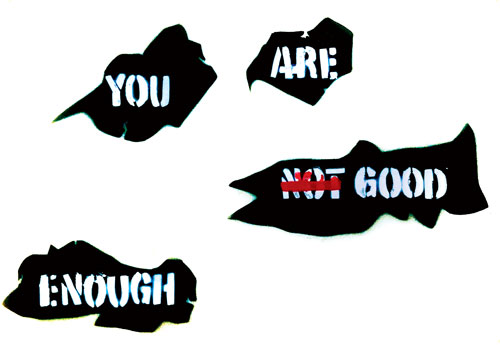Introducing social justice themes in the art room Issue-Based offers a way for students to express their knowledge and experiences with social issues to educate and create rich experiences for and with their peers.
I created this unit to facilitate my students in critiquing street artists such as Banksy, researching social issues, forming opinions, and creating meaningful artwork. Students create their own spray paint stencils that reflect personal feelings and opinions about social issues, backed up by research on their chosen topic.
Introducing Banksy
I begin the unit by facilitating a classroom critique of artwork by renowned street artist Banksy. I find the work of Banksy to be appropriate for this unit as he creates social and political commentaries about current issues often understood by my middle-school students. His use of satire also helps in teaching students how to creatively make a statement using sarcasm or humor. As a class, we examine the imagery and symbols that Banksy uses and discuss the intention of his artwork. Following our discussion, students break off into small groups and create mind maps of as many social issues as they can think of. I love this activity because it ignites so many conversations throughout the room.
Researching Social Issues
Next, students conduct research about their chosen topic. I explain to them that it’s important to be educated about what you’re making art about. Without learning about their topic first, students could be misunderstanding the issue or creating art that is uninformed. I developed a worksheet that guides them through finding related facts, brainstorming keywords and symbols associated with their chosen topic, and forming an opinion about a controversial topic.
Materials
The primary materials for this project are spray paint and craft knives, which make for an engaging and challenging lesson. Knowing that use of the materials are only available towards the final portion of the unit is a great incentive to work hard and persevere through challenges. Not only are students excited to see and use these materials, but they learn valuable lessons in safety and responsibility when learning how to use these potential high-risk materials.
Designing Stencils
Students design sketches to practice visually conveying their view on social issues using images and phrases, inspired by their research. After they refine their most successful sketch, I show them how to transform it into a stencil. I direct them to distill their drawings down to simple shapes and show a video of how a stencil works using spray paint. Students then cut out their final stencil designs using craft knives and spray paint them.
Reflections
This project challenges students to explore real-world issues that might affect them or their peers. Students frequently choose topics such as body image, immigration, racism, and low self-esteem. Others choose to delve deeper into global issues such as pollution, hunger, and gender equality. Whichever path they choose, the result is always meaningful and remarkable.
I want to teach my students to understand each other and the world around them through art-making. How can we change the world through art? How can we make others understand what might be happening in a life that is not their own? I believe using art for social justice in the classroom can build an understanding of multiple perspectives, help raise students’ social ethics, and instill a higher sense of social awareness and responsibility in school and the surrounding community.
I believe when working with social justice themes, it’s important to maintain a balance between artistic techniques and social and political critique. I want my students to understand that the visual arts go beyond media techniques and aesthetics, and can be connected to real issues and other disciplines.
Timothy Chavez is an art teacher at Whitcomb Middle School in Marlborough, Massachusetts. tchaves@mps-edu.org
NATIONAL STANDARD
Connecting: Relate artistic ideas and work with personal meaning and external context.
WEB LINK
Banksy Official Website: banksy.co.uk
View this article in the digital edition.





.jpg)